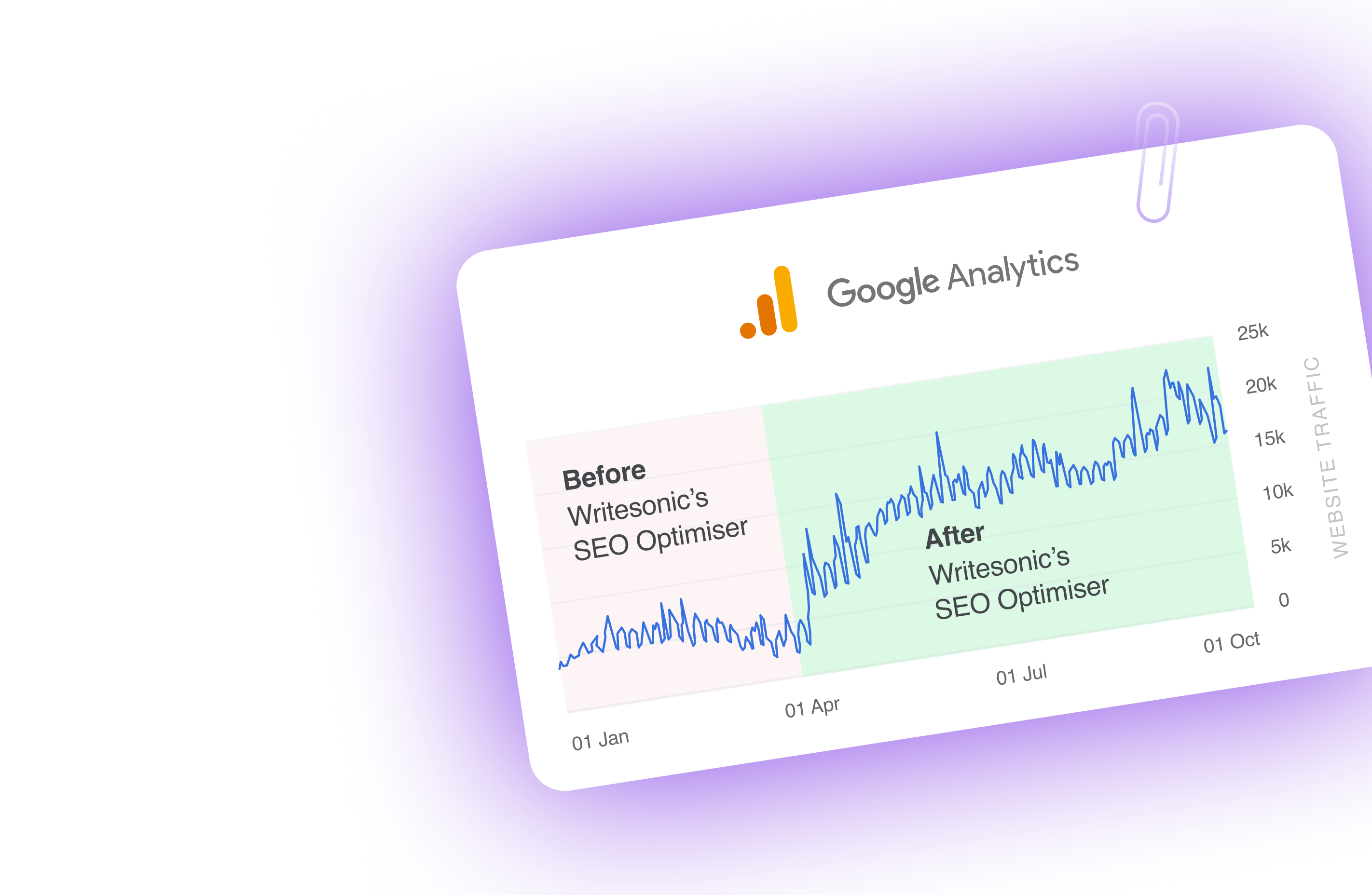Generative engine optimization is rewriting the rules of SEO.
For years, optimizing for search meant understanding how Google indexed and ranked web pages. Keywords, backlinks, technical SEO—all of it revolved around matching content to a static search results list.
But this model is fading fast. With Google’s AI Overviews, AI chatbots, and new AI search methods, users are not just searching for pages of links—they want instant, AI-generated answers.
So, if your content isn’t optimized for this shift, you’re invisible.
In this guide, you’ll learn:
- What is generative engine optimization
- All about generative SEO and how it differs from traditional SEO
- Seven ways to optimize content for AI-powered search
- How to future-proof your SEO strategy for AI-driven search
Let’s dive in.
What is generative engine optimization?
Generative engine optimization (GEO) is the process of making content discoverable, interpretable, and usable by AI-driven search experiences.
Unlike traditional SEO, which optimizes for Google’s static ranking factors, GEO focuses on ensuring AI-generated responses are pulled from your website.
Why does GEO matter?
Search engines are no longer just indexing pages. They’re summarizing, synthesizing, and generating answers in real time. This means your content needs to be structured in a way that AI models can extract and trust.
Gartner predicts that users will seek answers from generative AI tools like ChatGPT and Claude rather than Google Search, resulting in a 25% drop in conventional search volume by 2026.
AI-generated search results aren’t just influenced by traditional ranking factors.
Google’s AI Overviews, Microsoft’s Copilot, and AI chatbots pull information dynamically. This means:
- Content that isn’t structured properly won’t be cited in AI search models.
- AI models prioritize sources they consider authoritative.
- Your content’s format, language, and credibility influence whether AI includes it in responses.
GEO ensures your content is AI-friendly—not just for traditional rankings but for the new wave of generative search experiences.
How does generative SEO work?
First of all, let’s understand what is generative SEO:
Generative SEO ensures AI models recognize, understand, and prioritize your content when generating search responses.
When your content is optimized for GEO, it will have more chances of being noticed by Google’s AI overviews (formally known as SGE) and appear in AI-generated outputs produced by AI chatbots.
For example, here’s how generative engine optimization is able to pick up Writesonic’s blog about B2B AI agents for Google’s AI Overview in SERPs:
Here’s how generative engine optimization works:
- Structured data and schema markup: AI models rely on structured data to understand context. Without the right schema markups, your content may be overlooked.
- Clear, citation-friendly formatting: AI favors well-organized content with concise, direct answers that fit into generated responses.
- Credibility and source authority: If your content lacks citations, stats, or expert-backed insights, AI may deprioritize it.
- Conversational and intent-based optimization: AI pulls from sources that match user intent, not just keywords. That means optimizing for questions, comparisons, and natural language queries.
- Technical AI optimization: Fast-loading, well-structured, and AI-accessible content performs better in generative search models.
In short, GEO is not replacing traditional search engine optimization but adding a new layer of optimization. If you’re only optimizing for Google’s blue links, you’re missing out on the future of AI-powered search.
💡 Learn more about: How to Improve SEO Fast and 12 Hacks to Boost Your Rankings
What makes GEO different from traditional SEO (GEO vs. SEO)
Generative engine optimization (GEO) and traditional search engine optimization (SEO) both aim to enhance content visibility, but they differ significantly in approach and execution.
Let’s take a look at their differences and similarities:
Key differences in approach:
- Target platforms: SEO focuses on traditional search engines like Google and Bing, optimizing content to rank higher in search engine results pages (SERPs). In contrast, GEO targets AI-driven platforms and answer engines that generate synthesized responses, such as Google’s AI Overviews.
- Content structuring: SEO emphasizes keyword optimization, meta tags, and backlinks to improve rankings. But GEO requires content to be contextually rich and structured so that AI algorithms can easily interpret and generate comprehensive responses.
- User intent understanding: While SEO matches keywords to user queries to drive traffic, GEO leverages advanced AI to interpret and anticipate user intent more accurately, delivering more nuanced and precise responses.
- Information synthesis: SEO aims to improve the ranking of individual pages, whereas GEO focuses on how AI synthesizes content from multiple sources to provide comprehensive answers.
Similarities between GEO and SEO:
- Content quality and relevance: Both GEO and SEO emphasize the importance of high-quality, relevant content that meets user needs and adheres to Google’s E-E-A-T (experience, expertise, authoritativeness, and trustworthiness) principles.
- Technical optimization: Both require attention to technical aspects like load speed and mobile-friendliness and ensuring search engines can effectively crawl and understand content.
- Authority Building: Both build authority through credible content and relationships, focusing on enhancing trustworthiness and reliability.
- Continuous Adaptation: Both involve ongoing adaptation to changes in algorithms and technology to maintain and improve content visibility and performance.
In summary, while GEO and SEO share foundational principles in content quality and technical optimization, GEO requires a more nuanced approach to align with the capabilities and expectations of AI-driven search platforms.
💡 You might also like: Agentic AI vs Generative AI
Benefits of generative engine optimization and why you need GEO in 2025
Traditional search engine optimization is seeing a massive shift with the emergence of artificial intelligence.
For years, businesses optimized for Google SERPs, focusing on keyword rankings and backlinks. But with AI-powered search engines generating direct answers, search traffic is no longer guaranteed—unless your content is part of the AI-generated response.
Businesses that fail to optimize for AI-driven search will see declining visibility, traffic, and engagement.
Still not convinced? Let’s take a look at more reasons why you should prioritize AI optimization for generative SEO:
1. Expansion of AI search
AI search optimization is becoming increasingly important as more users rely on AI-powered platforms for information retrieval. The numbers speak for themselves:
- Gartner predicts that by 2028, organic search traffic of brans will decrease by 50% or more as consumers embrace generative AI-powered search.
- 79% of consumers are expected to use AI-enhanced search by 2026.
This rapid expansion of AI search engines means businesses must adapt quickly or risk being left behind. GEO ensures your content is optimized for these AI-driven platforms, maintaining your visibility as search habits evolve.
2. Impact on organic search
The rise of AI is reshaping organic search results in profound ways. First of all, traditional SEO metrics are being supplemented by AI-driven factors like user intent and content quality.
Optimizing for GEO leads to enhanced content visibility across various AI-powered search platforms and traditional search engines alike.
Businesses can improve their chances of appearing in AI-generated snippets and traditional search results by focusing on comprehensive, well-structured content that addresses user intent.
3. Changing user search behavior
User search patterns are evolving rapidly. 70% of users now trust AI’s answers as much as traditional sources. More importantly, there’s now a growing preference for conversational queries and direct answers over traditional link-based results.
Generative engine optimization helps businesses align their content with these new search behaviors.
Also, users aren’t just searching differently—they’re expecting different types of results.
For example, a few years ago, people might have Googled: “Best productivity tools for remote teams”
Today, they ask AI tools like ChatGPT “Give me a list of the top productivity tools and their pros and cons.”
The difference is:
- Users today expect full, AI-generated answers, not just a list of links.
- People want to search in a more conversational way, like talking to a personal assistant.
- They want AI-curated insights, not just raw search results.
This means that if your content isn’t optimized for these AI-powered queries, it won’t surface in any results—traditional or AI-generated.
Companies can ensure their content remains relevant and easily discoverable by optimizing for natural language processing and question-answering formats.
4. Future-proofs your SEO strategy
Adopting generative SEO methods ensures your content remains relevant and visible as search technology evolves.
Unlike traditional SEO, which mainly focuses on ranking for search engine results, GEO ensures:
- Your content is cited in AI-generated answers.
- AI models recognize and trust your content.
- You remain visible as AI search engines evolve.
By investing in GEO now, businesses are positioning themselves at the forefront of how AI continues to evolve. It’s not just about staying current; it’s about preparing for a future where AI-driven search is the norm.
5. Increases reach and visibility
GEO significantly expands a business’s digital footprint:
- Generative engine optimization enables content to appear in AI-generated snippets, featured answers, and across various AI-powered platforms.
- GEO-optimized content is more likely to be cited and referenced by AI systems, increasing overall visibility.
GEO ensures your content is discoverable everywhere AI generates answers and content—not just for Google SERPs.
As a result, generative engine optimization is not just a trend—it’s a fundamental shift in how businesses approach digital visibility.
💡 Also read: How to Avoid AI Detection in Writing
How to do generative engine optimization for better visibility
AI-driven search engines don’t rank content the same way Google does. Instead of serving up a list of blue links, AI tools like Google’s AI Overviews (formerly SGE) and AI chatbots synthesize responses from multiple sources and generate a single, AI-curated answer.
So, how do you ensure your content is part of that AI-generated response?
Unlike traditional SEO, where rankings depend on backlinks, keyword density, and technical optimization, GEO is about content structure, AI readability, and contextual authority.
Here are seven ways you can optimize for AI search engines and get your content noticed:
1. Content optimization techniques
AI search engines don’t just scan for keywords—they look for content structured in a way that’s easy to synthesize into AI-generated responses.
GEO prioritizes content that directly answers user questions. Instead of vague, keyword-stuffed introductions, get straight to the point.
Here’s how you can make your content more answer-focused so that your content gets recognized by AI search engines:
- Use question-based subheadings like “How does generative SEO work?” instead of “Generative SEO Overview”
- Structure answers in concise, skimmable paragraphs. AI models pull from clear, direct answers, not lengthy explanations.
- Summarize key points at the beginning of blog sections so AI doesn’t need to dig through your content.
- Example: Instead of starting a blog with “SEO has evolved significantly over the years…” begin with: “Generative Engine Optimization (GEO) helps content appear in AI-generated search results by structuring information in a way that AI can easily understand and cite.”
2. Use conversational formatting
AI models like ChatGPT and Perplexity prioritize conversational content because it matches how people search. As a result, AI-generated results often mirror conversational queries.
And your content should reflect that.
To adopt a more conversational tone for your content, here’s what you should do:
- Avoid overly technical, robotic writing.
- Write in a natural, question-and-answer style.
- Use second-person language (“you” instead of “users”).
3. Keyword optimization (But not in the traditional way)
Keywords still matter, but not in the same way they do for Google’s search engine rankings. AI search models look for context and intent, not just keyword matches.
GEO requires optimizing for full-length, question-based queries that match search intent. Here’s how you can prioritize your keyword research for GEO:
- Use long-tail, conversational keywords (e.g., “How does AI impact SEO rankings in 2025?”)
- Incorporate contextual variations. AI understands synonyms, so don’t overuse the exact keyword.
- Focus on topics, not just keywords. AI favors well-rounded content over exact-match keyword stuffing.
For example, instead of using the phrase “generative SEO strategies” repeatedly, structure your content to explain those strategies in depth. Organize content around pillar topics and related subtopics.
This helps AI systems understand the breadth and depth of your content.
💡 You might also like: How Many SEO Keywords Per Page Should You Use?
4. Use of schema and structured data
Google’s AI Overviews and other generative search tools rely heavily on structured data to understand the content context.
Here are the kinds of schema markups you can implement for GEO:
- FAQ schema: Helps AI quickly identify Q&A-style content and pull answers directly.
- HowTo schema: Guides AI on step-by-step processes (great for tutorials).
- Article schema: Ensures your blog posts are readable and categorized correctly.
- Author markup: Helps establish credibility (Google’s AI prioritizes expert sources).
Apart from this, Google recommends using JSON-LD for structured data. It’s easier to implement and less prone to errors. You can use Google’s Schema Markup Validator or Rich Results Test to ensure correct implementation and troubleshoot any errors.
The more specific your structured data, the better. For example, use ‘datePublished’ and ‘dateModified’ for articles to signal freshness.
💡 Pro tip: Skip the manual work and use Chatsonic’s AI marketing agent to instantly generate SEO-friendly schema markups to boost your chances of getting featured in AI-driven search results.
5. Citing sources, quotations, and statistics
AI models prioritize credible sources—and they’re getting better at detecting unverified claims. Proper citation of sources not only boosts your content’s trustworthiness but also helps AI systems verify information
To increase your chances of being cited in AI-generated results:
- Use verifiable data from reputable sources like studies, whitepapers, and industry reports.
- Link to high-authority sites. Google AI trusts government, academic, and expert-backed sources.
- Use real-world examples because AI models favor case studies and proven insights over vague claims.
For example, instead of stating a generic claim like, “AI search is growing fast,” you can say, “According to Gartner, AI-powered search will reduce traditional search volume by 25% by 2026.”
Remember to use hyperlinks or parenthetical citations within your content. This helps both readers and AI systems trace information to its source.
While citing external sources is important, don’t forget to link to your own relevant content to establish topical authority.
6. Combining SEO and GEO
You’re probably thinking by now that generative search is here to replace traditional SEO, but on the contrary, GEO is only expanding it.
Here’s how to merge SEO best practices with GEO techniques:
- Continue building backlinks: AI still considers authority signals like backlinks, even though ranking algorithms are changing.
- Optimize for featured snippets: AI search models heavily reference structured snippets, so optimize for Google’s existing featured snippet formats.
- Create multi-format content: Diversify your content types. Include text, images, videos, and audio to cater to different user preferences and AI interpretation capabilities.
- Maintain technical SEO: Ensure your site is crawlable, has fast load times, and is mobile-friendly. These factors remain crucial for both traditional and AI-driven search.
- Monitor AI-driven analytics: Check your analytics to see how much traffic your website receives from AI tools like ChatGPT, featured snippet appearances, voice search rankings, and AI-generated summary inclusions.
- For example, here’s how much traffic Writesonic’s blog received in the past 30 days through ChatGPT:
7. Leveraging AI agents for GEO content optimization
Optimizing for GEO doesn’t have to be a painfully slow manual process. You can simply make Chatsonic, one of the best AI agents for generative engine optimization, do all the heavy lifting.
Here’s how this handy AI agent can help you rank for AI search results:
- Real-time web search: Ensures your content stays up-to-date with the latest trends, making it more relevant for AI-generated responses.
- AI-powered keyword research: Identifies high-impact, conversational, and intent-based keywords that AI models prioritize through Ahrefs integration.
- Trend analysis: Detects emerging search trends and user behavior shifts so your content stays ahead of the curve.
- Instant schema markup generation: Creates structured data (FAQ, HowTo, Article schema, etc.) to improve AI search visibility.
- Featured snippet optimization: Analyzes which content format AI engines prefer and helps tailor your content for maximum exposure.
💡 Learn more about: Chatsonic – The AI Agent Revolutionizing Marketing and SEO
Common GEO mistakes to avoid
1. Over-reliance on keywords
For years, traditional SEO has been centered around keyword optimization. While keywords remain important in GEO, AI search engines focus more on context and intent rather than exact-match keywords.
Another common mistake is keyword stuffing, where businesses overload their content with specific phrases in an attempt to rank higher.
This approach is ineffective in AI-driven search, where algorithms prioritize natural, conversational language over repetitive keyword usage.
To optimize your keywords for GEO, you should:
- Focus on long-tail, intent-driven keywords that align with how users phrase questions in AI search engines.
- Use variations and synonyms naturally within content instead of forcing exact-match phrases.
- Structure content around common user queries rather than simply inserting keywords throughout the text.
Your content should flow naturally in an informative manner while maintaining semantic relevance because AI algorithms are designed to reward content that provides value to readers, not just match search terms.
2. Producing low-quality or generic AI-generated content
Generative AI can streamline content creation, but publishing unedited, low-quality AI-generated content can damage credibility and limit visibility in AI search results.
Search engines are increasingly capable of detecting generic, low-value content and will deprioritize material that lacks depth or verification.
To avoid this mistake:
- Use AI content writing tools for drafting and research, but edit content manually to ensure accuracy, engagement, and clarity.
- Incorporate unique insights, expert opinions, and case studies to add depth.
- Verify all facts and statistics before publishing, as AI-generated content can sometimes contain misinformation.
A successful GEO strategy relies on a balance between AI efficiency and human expertise. AI can assist in generating outlines and content ideas, but human input is essential to make content engaging, authoritative, and credible.
3. Neglecting user intent
A significant mistake businesses make is writing for algorithms instead of real people, resulting in vague, overly technical content or misaligned with user expectations.
To avoid this mistake:
- Understand how users phrase questions in search engines and structure content to match those queries.
- Dive deep into your audience’s needs, questions, and pain points through Google’s “People Also Ask” feature or analyze long-tail keywords to understand the search context.
- Write in a natural, question-and-answer format, ensuring that each section provides a clear, useful response.
- Format content so AI models can easily extract information, such as using FAQ sections, bullet points, and well-defined subheadings.
For example, instead of structuring an article as:
“Generative SEO strategies are essential for AI search. They help businesses rank better and gain visibility.”
A more effective approach is:
“How does generative SEO improve AI search visibility?
AI models prioritize well-structured content that answers user queries in a direct, factual manner. Businesses should use structured data, authoritative citations, and user-friendly formatting to ensure AI-generated search results include their content.”
By aligning content with how users phrase their searches, businesses improve their chances of appearing in AI-generated responses.
4. Not checking for factual accuracy
AI search engines prioritize credible, well-sourced content. Content containing misleading, outdated, or unverified claims will not be included in AI-generated search results.
A common mistake is publishing content without verifying sources or updating information regularly. AI models cross-reference multiple sources before generating responses, and inaccurate content is quickly deprioritized.
To maintain factual accuracy:
- Use trusted sources such as industry reports, academic research, and authoritative publications.
- Regularly update statistics and data to ensure information remains current.
- Clearly cite sources and include references where necessary to reinforce credibility.
Maintaining factual accuracy improves your E-A-T (Expertise, Authoritativeness, Trustworthiness) score and builds long-term trust with your audience.
5. Overlooking the human touch
While AI-generated search results prioritize structured and factual content, content that lacks human engagement, storytelling, or clear formatting often performs poorly.
A mistake many businesses make is writing robotic, overly formal content that does not engage users. AI search engines analyze user engagement metrics such as time spent on a page, bounce rates, and click-through rates.
Content that fails to capture reader interest may be deprioritized.
To avoid this mistake:
- Write in a natural, conversational tone that feels authentic and engaging.
- Use real-world examples, anecdotes, and personal insights to make content more compelling.
- Ensure formatting is user-friendly, with short paragraphs, bullet points, and clear takeaways.
Remember, your goal is to engage and provide value to real people, not just to rank well in search results.
The future of GEO: Role of large language models and AI in generative SEO
As we peer into the future of generative engine optimization (GEO), it’s clear that large language models (LLMs) and AI are set to change how we look at traditional search engines and SEO tactics.
Let’s dive into some eye-opening facts and trends we can expect in the near future:
1. Evolving search behavior
The way people search is changing dramatically.
According to Perplexity’s CEO, the average query length on AI-powered platforms like Perplexity has increased to 10-11 words, compared to just 2-3 words on traditional search engines.
This shift towards more conversational queries means we must rethink our content optimization approach.
2. Predictive and multimodal search
The future of search is not just text-based.
By 2025, it’s predicted that 50% of all searches will be either voice or image-based. Moreover, AI-driven predictive search is on the rise, with Google’s MUM algorithm already 1,000 times more powerful than its predecessor, BERT.
3. Real-time search and personalization changing search suggestions
Unlike traditional search engines, which index pages periodically, AI-driven search results will be updated in real time based on user intent, personalization, and emerging trends.
This means generative SEO will be all about:
- AI models generate different answers for different users based on browsing behavior, location, and preferences.
- Real-time trend detection allows AI search engines to prioritize fresh, up-to-date content.
- Content adapting to AI personalization will perform best—static, keyword-based content will fade out.
To prepare for this shift, businesses should:
- Leverage real-time trend analysis using AI agents to keep content fresh and AI-relevant.
- Use AI-powered search intent and keyword tools to understand how AI-driven searches evolve.
- Structure content to allow AI models to extract relevant information based on user preferences easily.
Are you ready to prioritize generative engine optimization?
AI-driven search isn’t coming—it’s already here. Businesses relying only on traditional SEO will see diminishing returns as AI search engines reshape how content is discovered and ranked.
The shift toward AI-generated search results means:
- Traditional SEO alone won’t be enough to stay visible.
- AI search engines will prioritize structured, authoritative content.
- GEO will determine which brands thrive in the AI era.
Manually keeping up with AI-driven search trends and real-time keyword shifts can be overwhelming. That’s where Chatsonic’s AI SEO agent helps.
Chatsonic can help you stay ahead of AI search changes with instant, up-to-date insights. And with Google Search Console and Ahrefs integrations, you can identify high-performing, intent-driven keywords for AI search visibility in seconds!
With its intuitive content AI agent, you can automatically structure content to match AI search preferences and maximize exposure.
Ready to future-proof your SEO strategy? Try Chatsonic today and see how it transforms your approach to GEO and helps you capitalize on these emerging trends.
FAQs
1. How does GEO differ from traditional SEO?
While traditional SEO emphasizes keyword density, backlinks, and technical site factors for ranking pages, GEO takes a broader approach.
Generative engine optimization involves optimizing for conversational queries, implementing structured data and clear schema markups, and highlighting authoritative content. This makes it easier for AI systems to pull and present your content in their real-time, AI-generated summaries and featured snippets.
2. Why is GEO important for AI-driven search?
As AI-powered search tools become more prevalent, users increasingly expect direct, synthesized answers rather than a list of links. GEO is crucial because it helps your content get recognized by these AI systems.
By focusing on structured data, clear formatting, and authoritative signals, generative engine optimization improves the likelihood that your content is cited in dynamic answer boxes and people also ask features.
3. What are the core elements of a GEO strategy?
An effective GEO strategy typically includes:
- Structured data and schema markup: Use FAQ, HowTo, and Article schema to enable AI engines to digest your content effortlessly.
- Conversational formatting: Write clear, concise answers that address user questions directly.
- Credibility signals: Incorporate verified data, citations, and expert insights to build trust.
- Intent-focused content: Prioritize long-tail, conversational keywords that mirror real user queries.
4. How Can I optimize my content for generative AI search results?
Start by structuring your content with clear headings and concise paragraphs, and incorporate FAQ sections where possible.
Use conversational language and include structured data (JSON-LD) according to Google’s guidelines. Additionally, continuously update your content and verify data accuracy to keep pace with evolving AI search algorithms.
5. Is GEO replacing SEO?
No, generative engine optimization is not replacing search engine optimization, but rather complementing and expanding it. Traditional SEO remains crucial for visibility in conventional search engine results pages (SERPs).
As AI-driven search experiences become more prevalent, GEO is emerging as an essential extension of SEO practices because they work together to ensure comprehensive online visibility. While SEO focuses on ranking in traditional search results, GEO optimizes for AI-generated responses and featured snippets.
As search engines incorporate more AI-driven features, the line between SEO and GEO is blurring. Implementing GEO strategies can enhance your overall search performance.
Unlike traditional SEO, generative engine optimization addresses the growing user preference for quick, direct answers.
For optimal results, businesses should integrate both SEO and GEO strategies in their digital marketing efforts.

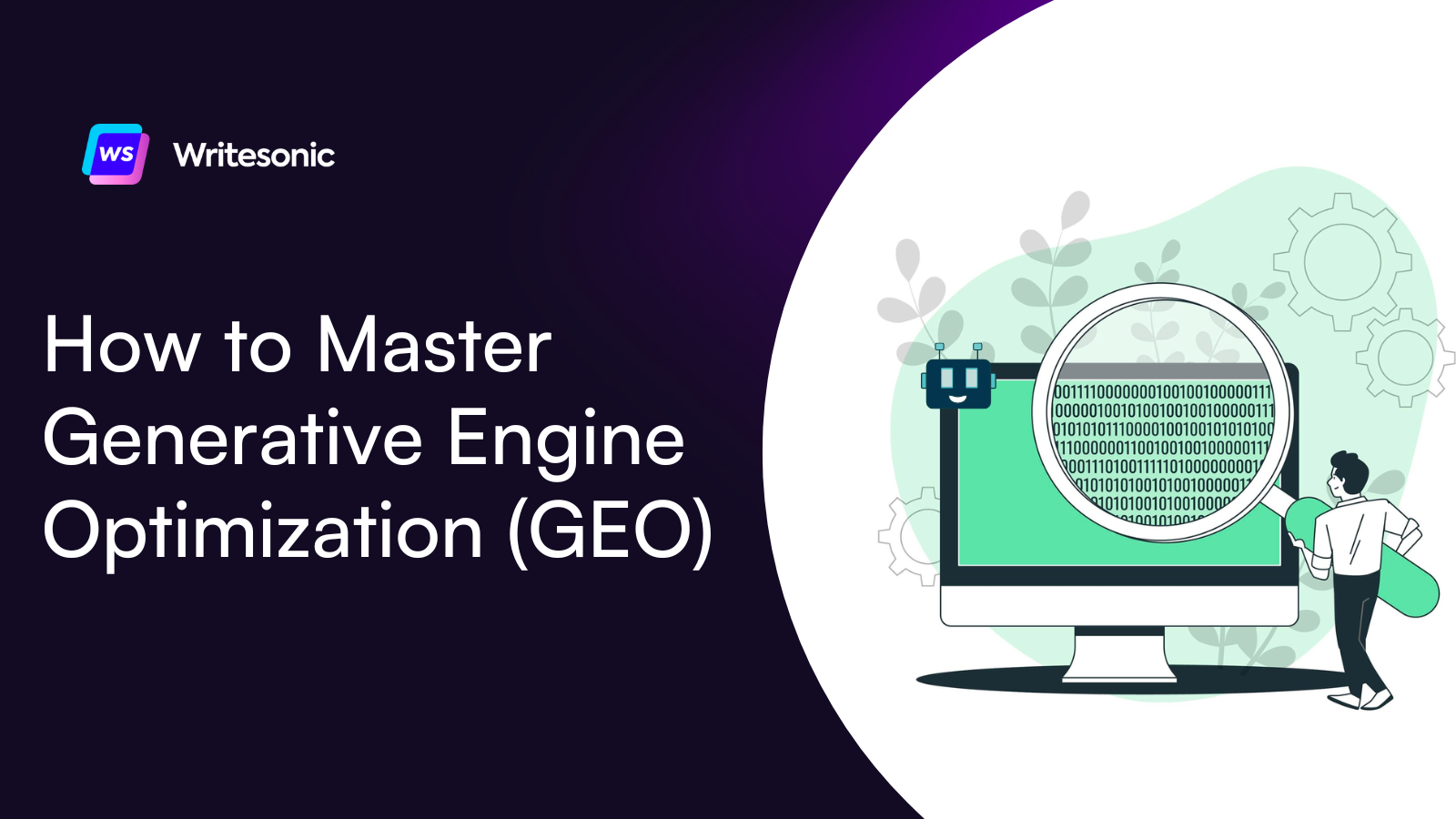
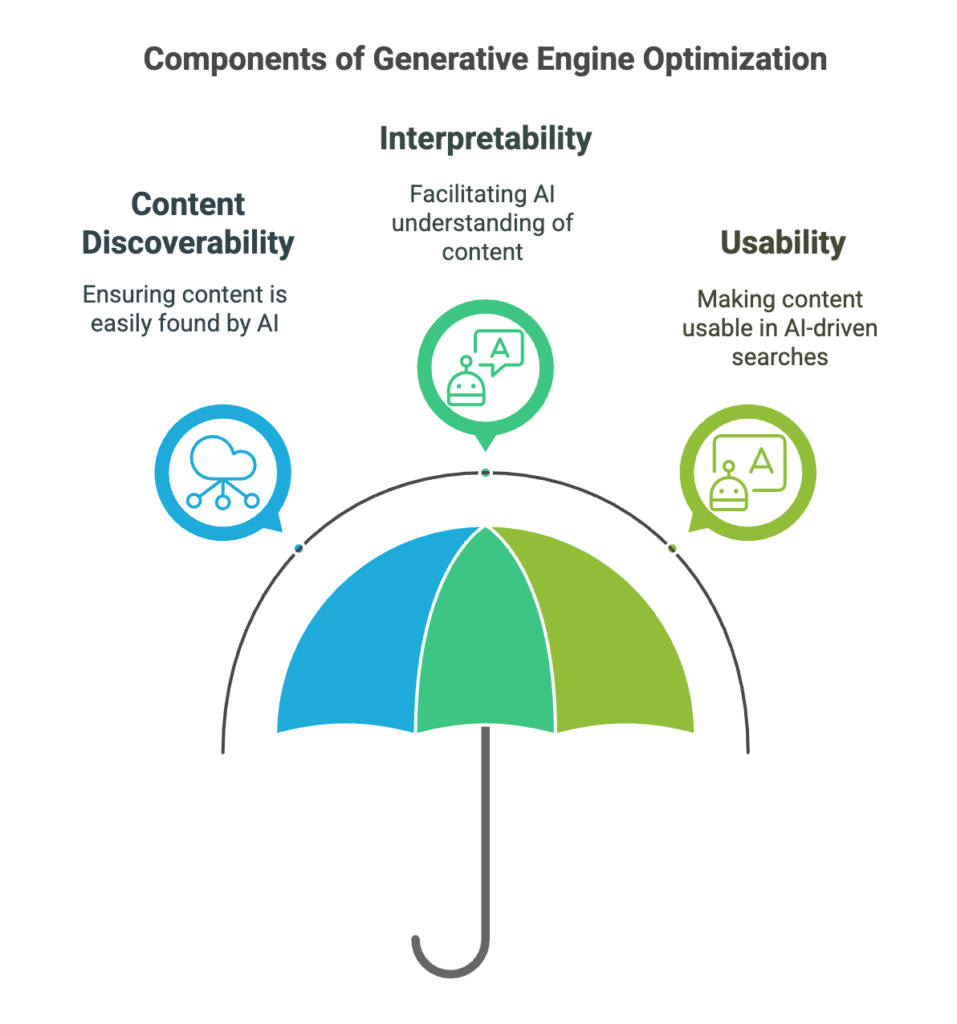
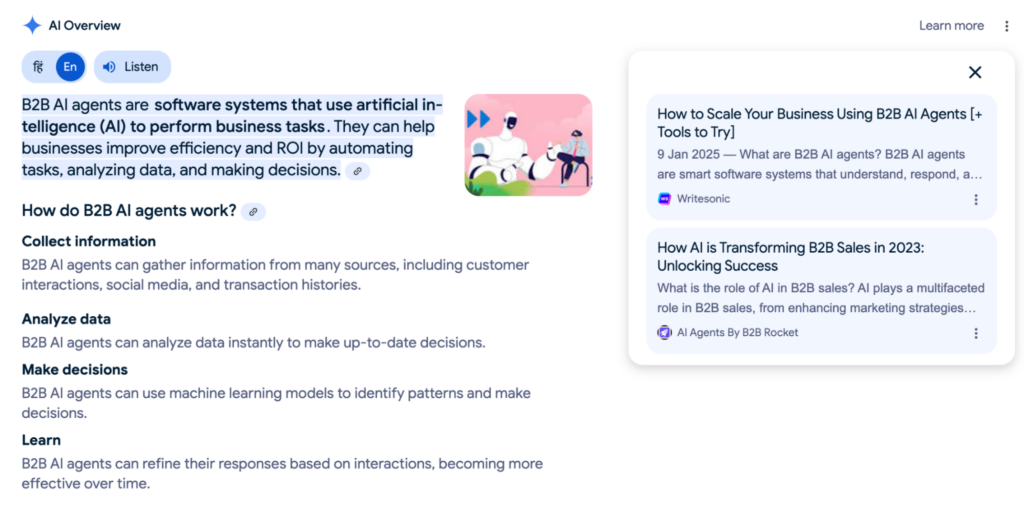

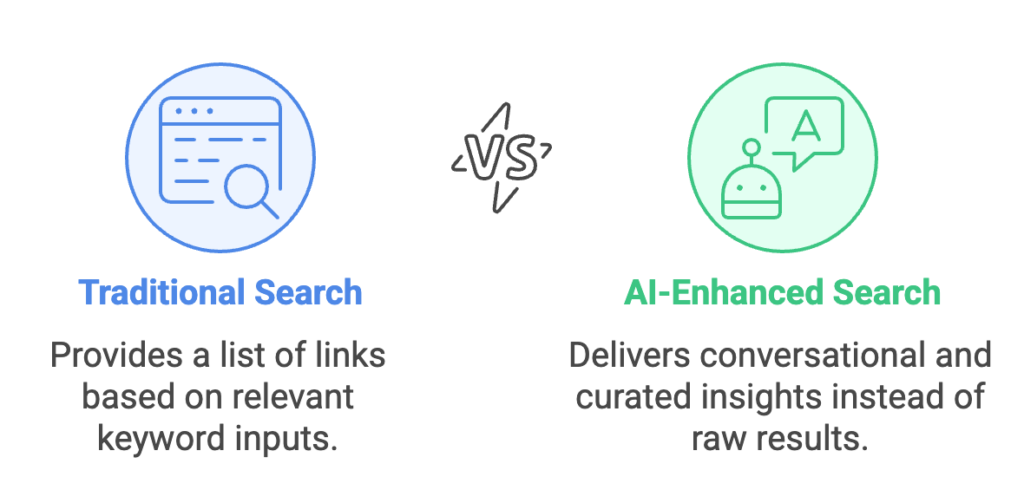
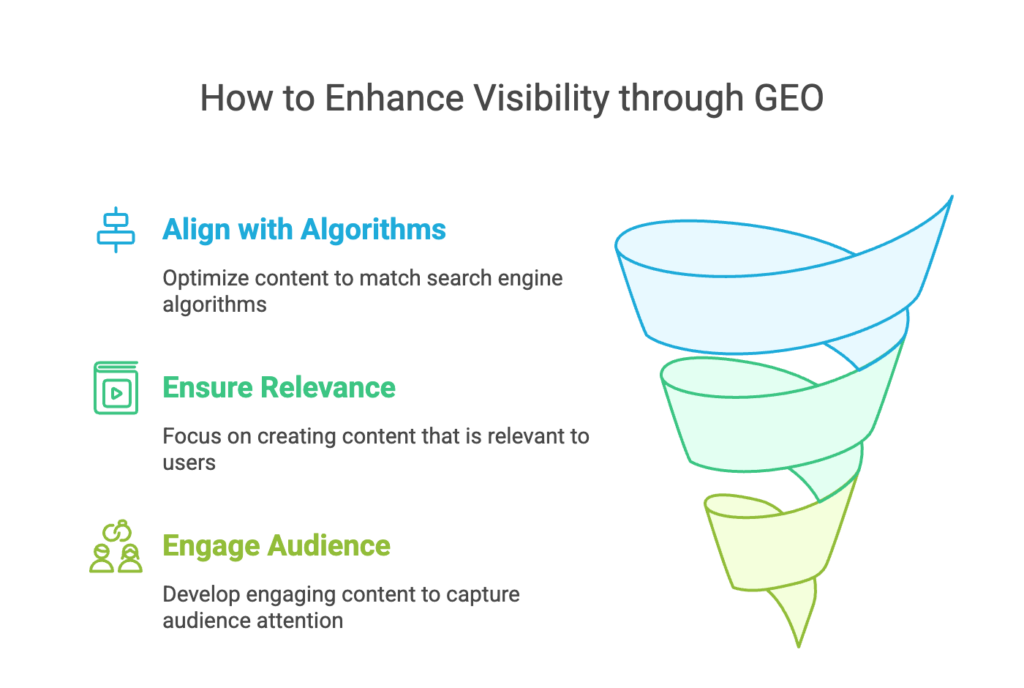
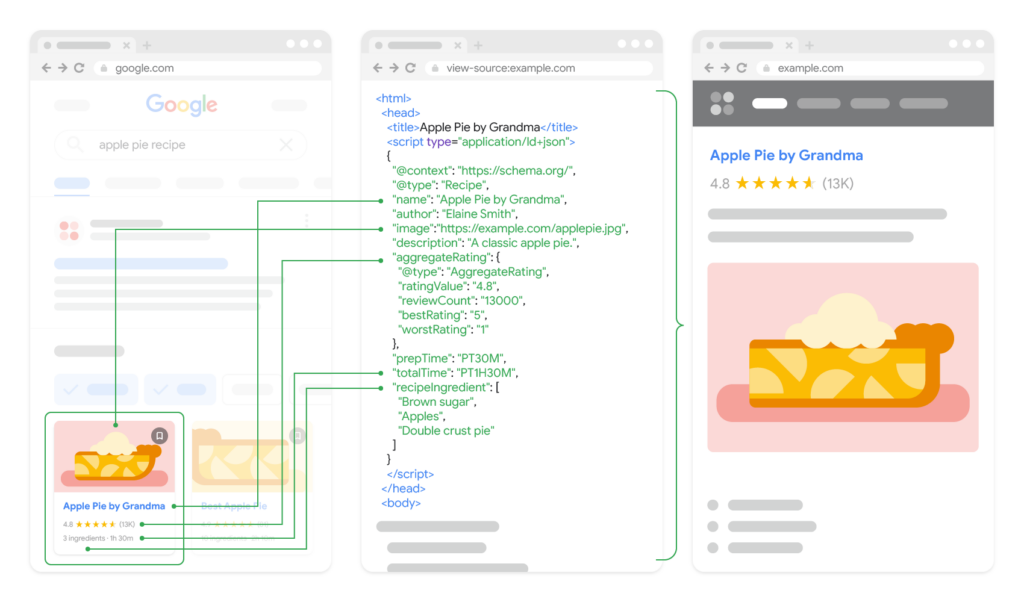
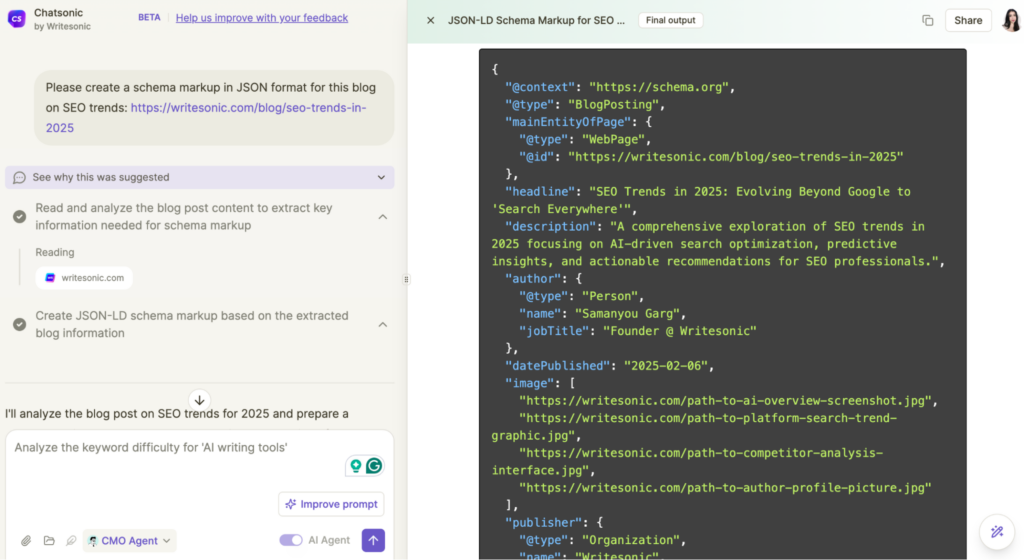

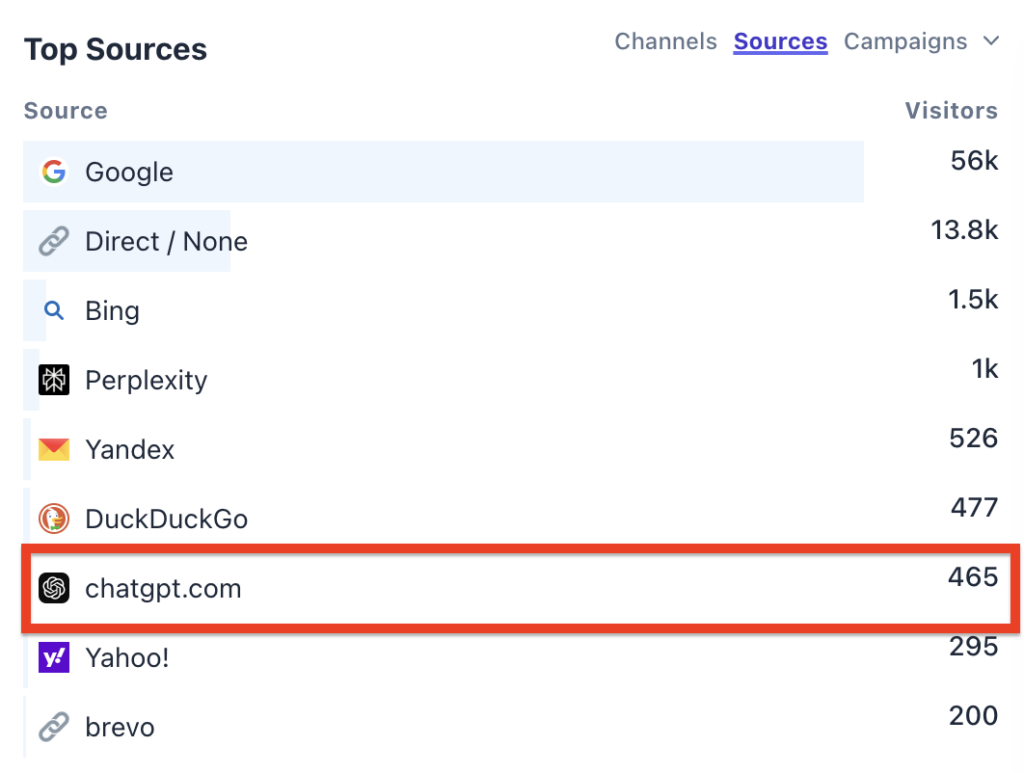
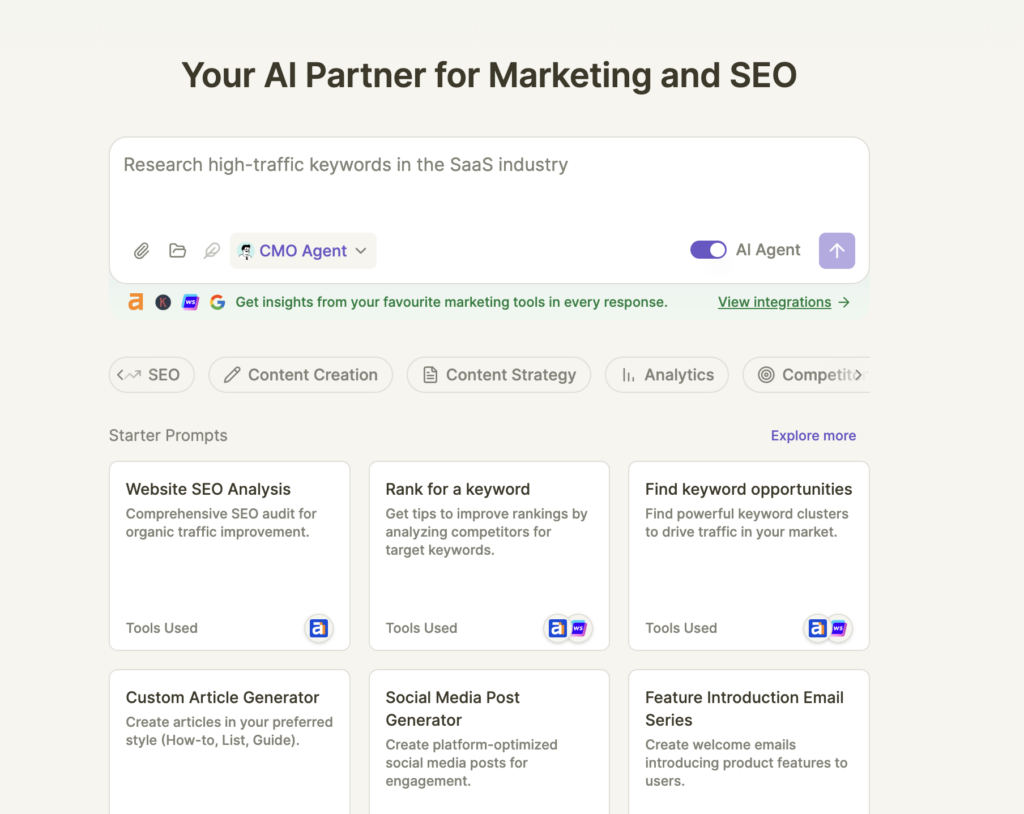
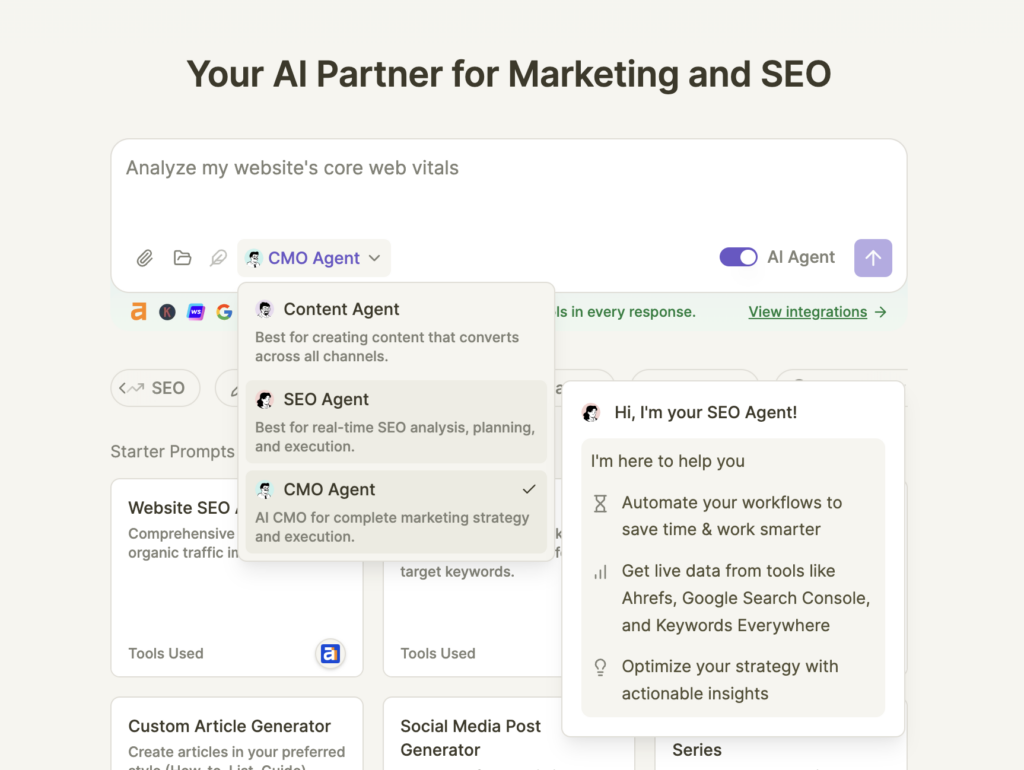

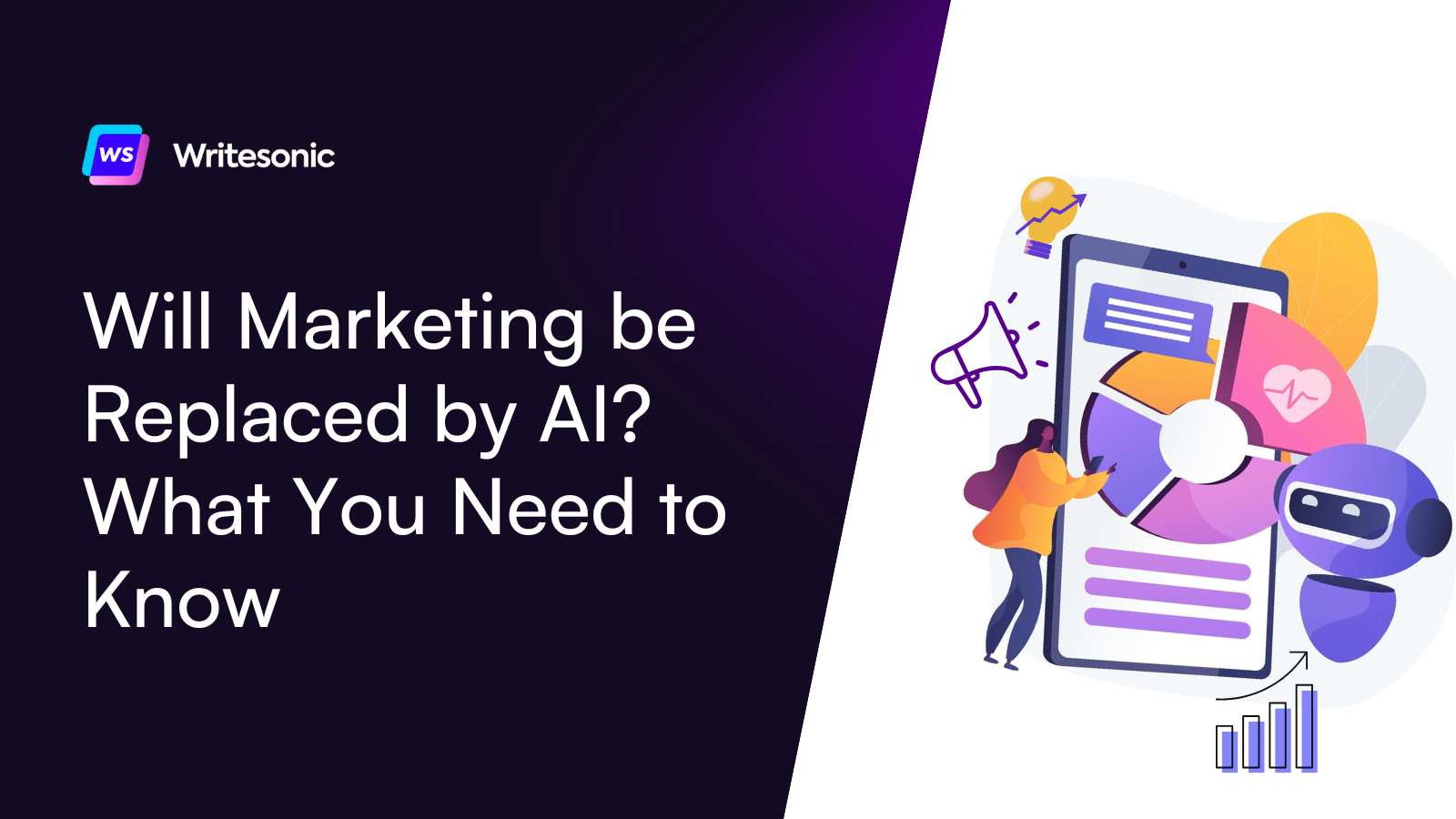

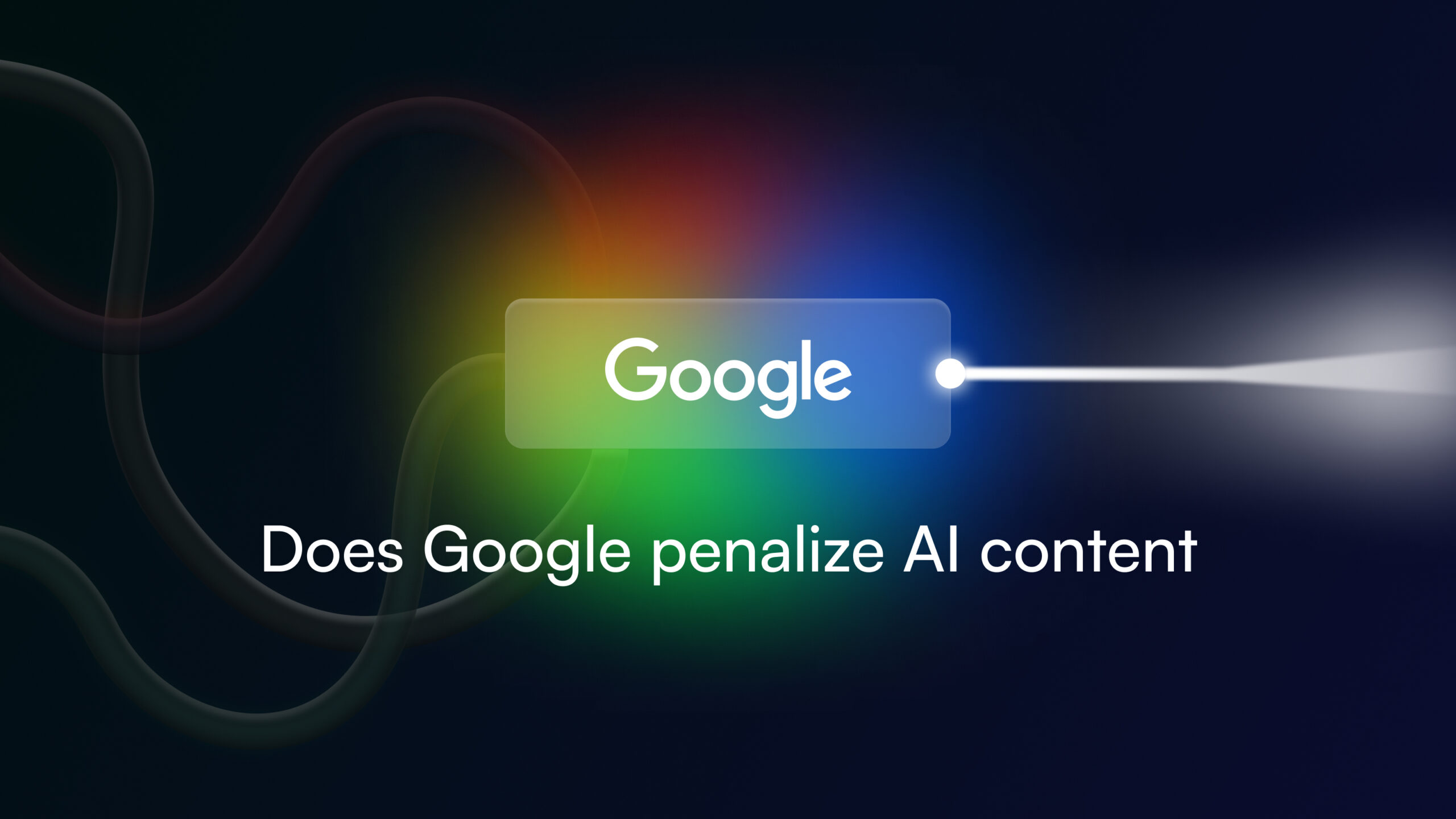





![21 Practical Ways to Use AI [Examples + Tools]](/wp-content/uploads/How-to-use-AI-scaled.jpg)

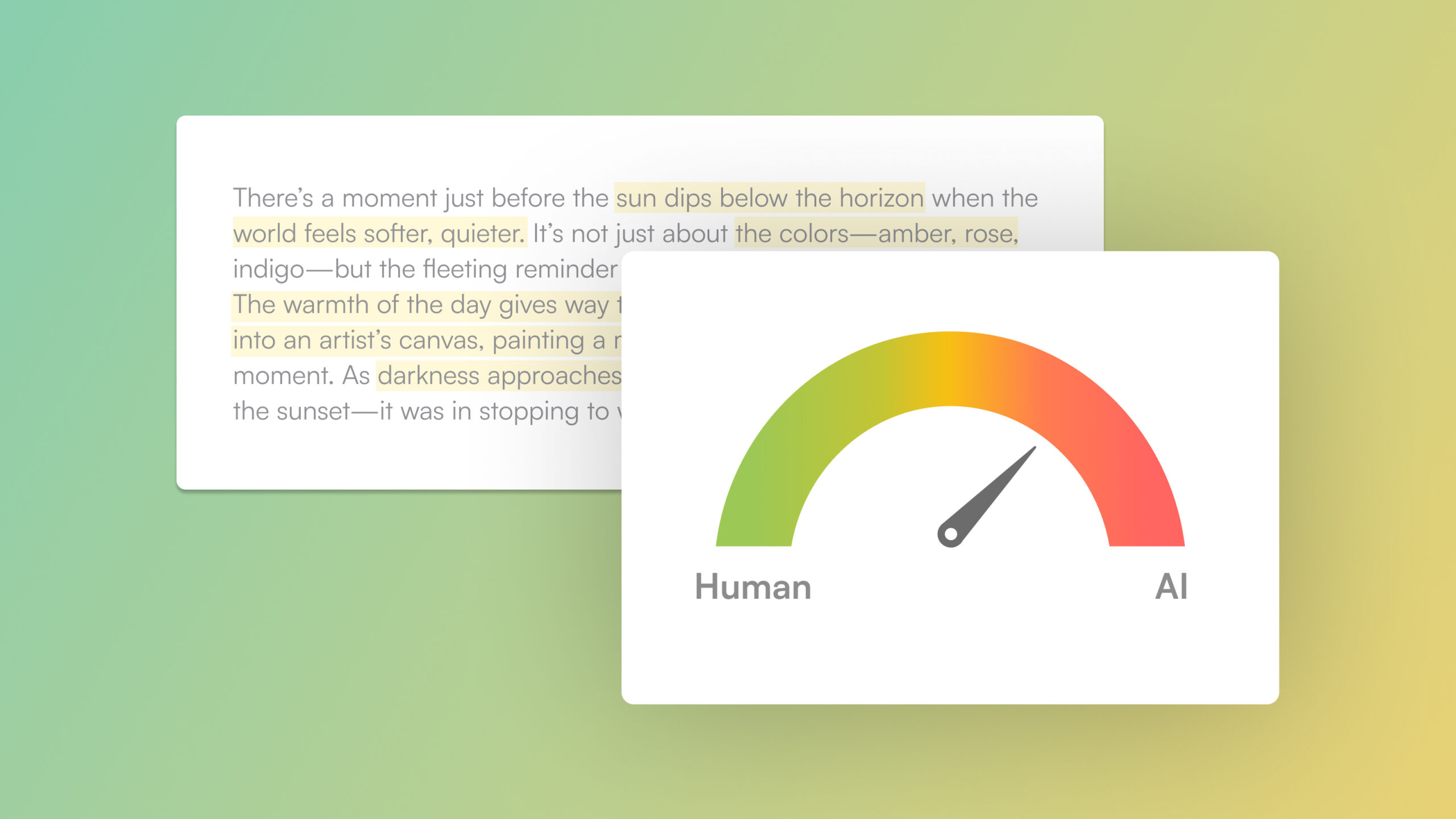

![140 Best AI Tools: Rated & Reviewed [2025]](/wp-content/uploads/Best-AI-Marketing-Tools-1-1.jpg)














